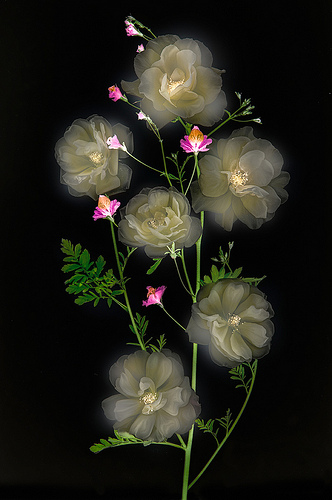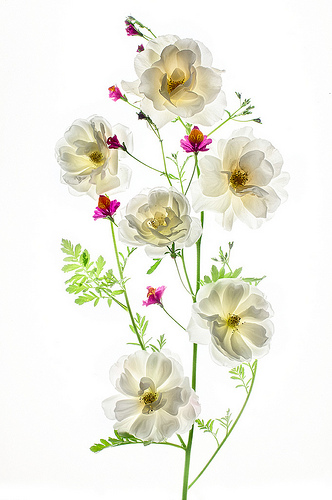I noticed some white “Iceberg” roses growing in a corner of my garden. Their lovely white-on-white shapes truly appealed to me, but I knew all the whiteness would cause difficulties in terms of tonal separation when I photographed the roses on white.

Every floral composition needs some structure, and to create a structure for my white roses I laid a stem of Schizanthus grahamii on the background next to my lightbox. Schizanthus is sometimes called a “Butterfly flower” not so much because it attracts butterflies but because it is shaped like a colorful butterfly.
Here’s a story I wrote about arranging floral compositions for photography that explains what I mean about creating a structure.
Laying the white roses on top of the Schizanthus, with my camera on my tripod, I shot six exposures as is my wont—with shutter speeds ranging from one second to 1/100 of a second. Each exposure was at f/10 and ISO 100.
I combined the exposures starting with the lightest one-second exposure using hand-layering in Photoshop. I also used Nik HDR Efex Pro to create a blend that added some definition to the layered image, and could be added using Luminosity blending mode. The initial results are shown below.

I liked the delicacy of the white-on-white roses on the white background, but I decided to see what they would look like on black. To accomplish this, I converted the image to LAB color and applied an inversion adjustment to the L channel of the image. This swapped black for the white of the background, but as a result the roses were a little too dark.
So a painted the flowers in the original of the white-on-white version back over the inverted version at low opacity. The result is a slightly spooky version of ghostly flowers, probably best viewed large.
Odds and ends: If you are interested in an exciting photography workshop in the northeast, check out powerhouse photographer Hank Gans and his Golden Light photography intensive at Gibson House, a sweet New Hampshire bed & breakfast in mid August.
Pingback: Red Poppies